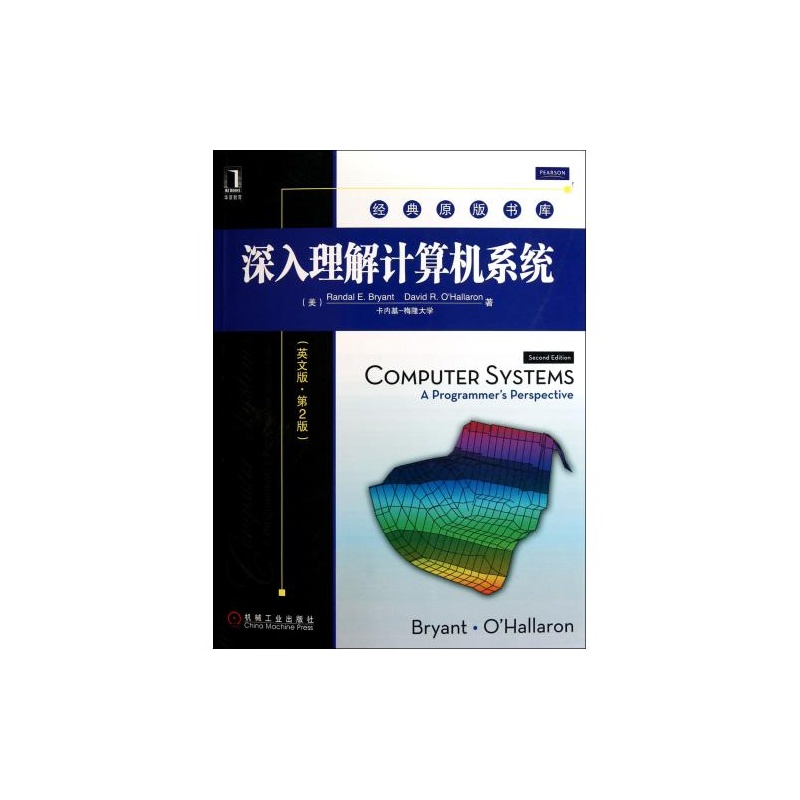《經典原版書庫:深入理解計算機系統》是2011年1月1日機械工業出版社出版的圖書,作者是布萊恩特(Randal E.Bryant)。
基本介紹
內容簡介,作者簡介,媒體推薦,圖書目錄,
內容簡介
《深入理解計算機系統(英文版·第2版)》是將計算機軟體和硬體理論結合講述的經典教程,內容覆蓋計算機導論、體系結構和處理器設計等多門課程。《深入理解計算機系統(英文版·第2版)》的最大優點是為程式設計師描述計算機系統的實現細節,通過描述程式是如何映射到系統上,以及程式是如何執行的,使讀者更好地理解程式的行為為什麼是這樣的,以及造成效率低下的原因。 相對於第1版,本版主要是反映了過去十年間硬體技術和編譯器的變化,具體更新如下: 對系統的介紹(特別是實際使用部分)做了增加和修改。例如,既保持了原有的針對32位系統的說明,又增加了對64位系統的描述。 增加了很多關於由算術運算溢出以及緩衝區溢出造成安全漏洞的內容。 更詳細講述了處理器對異常的發現和處理。 描述了基於IntelCorei7處理器的存儲器層次結構,還增加了固態硬碟的內容。 強調並發性.增加了關於並發性一般原則的內容。 海報:
《深入理解計算機系統(英文版·第2版)》:經典原版書庫。
作者簡介
作者:(美國)布萊恩特(Randal E.Bryant) (美國)奧哈拉倫(David R.O'Hallaron)
布萊恩特(Randal E.Bryant),1973年獲得密西根大學學士學位,隨即就讀麻省理工學院的研究生院,並在1981年獲得計算機博士學位。從1984年至今一直任教於卡內基-梅隆大學,現在是卡內基-梅隆大學計算機科學學院院長、教授,同時受邀任教於工學院電子與計算機工程系。他還是ACM院士、IEEE院士和美國國家工程院院士。其研究成果獲得過數項大獎,其中包括Semiconductor Researh Corporation頒發的兩個發明榮譽獎和一個技術成就獎,ACM頒發的Kanellakis理論與實踐獎,還有IEEE頒發的W.R.G.Baker獎、Emmanuel Piere獎和Phil Kaufman獎。
奧哈拉倫(David R.O'Hallaron),擁有維吉尼亞大學計算機科學博士學位,現為Intel匹茲堡實驗室主任,卡內基-梅隆大學計算機科學和電子與計算機工程副教授,他曾獲得卡內基-梅隆大學計算機科學學院頒發的Herbert Simon傑出教學獎,並同Quake項目中其他成員一起獲得了高性能計算領域中的最高國際獎項——Gordon Bell獎
布萊恩特(Randal E.Bryant),1973年獲得密西根大學學士學位,隨即就讀麻省理工學院的研究生院,並在1981年獲得計算機博士學位。從1984年至今一直任教於卡內基-梅隆大學,現在是卡內基-梅隆大學計算機科學學院院長、教授,同時受邀任教於工學院電子與計算機工程系。他還是ACM院士、IEEE院士和美國國家工程院院士。其研究成果獲得過數項大獎,其中包括Semiconductor Researh Corporation頒發的兩個發明榮譽獎和一個技術成就獎,ACM頒發的Kanellakis理論與實踐獎,還有IEEE頒發的W.R.G.Baker獎、Emmanuel Piere獎和Phil Kaufman獎。
奧哈拉倫(David R.O'Hallaron),擁有維吉尼亞大學計算機科學博士學位,現為Intel匹茲堡實驗室主任,卡內基-梅隆大學計算機科學和電子與計算機工程副教授,他曾獲得卡內基-梅隆大學計算機科學學院頒發的Herbert Simon傑出教學獎,並同Quake項目中其他成員一起獲得了高性能計算領域中的最高國際獎項——Gordon Bell獎
媒體推薦
“這是我所看過的介紹有關計算機系統核心內容的最好教材之一,視角獨特,內容豐富,系統性強,將高層的程式設計和中間層次的存儲管理、編譯最佳化、連結等內容,以及底層的計算機硬體多個方面有機結合起來,深刻揭示了計算機硬體和軟體之間的內在聯繫。它是一本值得計算機專業人員好好閱讀的教科書。”
——袁春 風南京大學
“自2002年本書剛出版起,我就嘗試將其作為本科生教材,迄今已先後教授十屆學生,始終深受學生喜愛。本書最大的優點就在於採用了全新的視角安排教學內容,克服了傳統教材割裂軟、硬體之間聯繫的局限,同時採用主流的x86/Linux作為實例,很好地實現了理論和實踐的結合。在此次全面更新的第2版中摒棄了第1版中部分不太重要或者比較瑣碎的內容,大幅增加了最新的64位體系結構和作業系統方面的內容,突出了並發程式設計的重要性,提高了本書的時代性和適用性。全新的網際網路時代已經來臨,傳統的計算機教學體系正面臨變革,本書必將成為新一輪改變的基石。”
——臧斌宇 復旦大學
“2005年,我開始採用Bryant和O'hallaron的這本書作為本科生計算機系統課程的教材。現今,這本書仍然是我的計算機系統課程資料書的首選。”
——Mirela Danlian,維拉諾瓦大學
“本書表述清晰、恰到好處——舉重若輕塏呈現了那些非常複雜的內容。”
——Ibrahim Matta,波士頓大學
“這是一本學習計算機硬體和軟體如何‘真正’協同工作的好書,還教會你為什麼了解這些知識會便你成為一個更有價值的程式設計師。本書還幫你約掌習像作業系統和編譯器這樣的高級課程做好準備。在本書中,我最喜歡的章節是關於快取的,當我第一次發現快取有多重要時,真是難以置信!”
——vishal shah,Ask.com總架構師
——袁春 風南京大學
“自2002年本書剛出版起,我就嘗試將其作為本科生教材,迄今已先後教授十屆學生,始終深受學生喜愛。本書最大的優點就在於採用了全新的視角安排教學內容,克服了傳統教材割裂軟、硬體之間聯繫的局限,同時採用主流的x86/Linux作為實例,很好地實現了理論和實踐的結合。在此次全面更新的第2版中摒棄了第1版中部分不太重要或者比較瑣碎的內容,大幅增加了最新的64位體系結構和作業系統方面的內容,突出了並發程式設計的重要性,提高了本書的時代性和適用性。全新的網際網路時代已經來臨,傳統的計算機教學體系正面臨變革,本書必將成為新一輪改變的基石。”
——臧斌宇 復旦大學
“2005年,我開始採用Bryant和O'hallaron的這本書作為本科生計算機系統課程的教材。現今,這本書仍然是我的計算機系統課程資料書的首選。”
——Mirela Danlian,維拉諾瓦大學
“本書表述清晰、恰到好處——舉重若輕塏呈現了那些非常複雜的內容。”
——Ibrahim Matta,波士頓大學
“這是一本學習計算機硬體和軟體如何‘真正’協同工作的好書,還教會你為什麼了解這些知識會便你成為一個更有價值的程式設計師。本書還幫你約掌習像作業系統和編譯器這樣的高級課程做好準備。在本書中,我最喜歡的章節是關於快取的,當我第一次發現快取有多重要時,真是難以置信!”
——vishal shah,Ask.com總架構師
圖書目錄
出版者的話
前言節選
Preface
1 About the Authors
A Tour of Computer Systems
1.1 Information Is Bits + Context
1.2 Programs Are Translated by Other Programs into Different Forms
1.3 It Pays to Understand How Compilation Systems Work
1.4 Processors Read and Interpret Instructions Stored in Memory
1.4.1 Hardware Organization of a System
1.4.2 Running the hello Program
1.5 Caches Matter
1.6 Storage Devices Form a Hierarchy
1.7 The Operating System Manages the Hardware
1.7.1 Processes
1.7.2 Threads
1.7.3 Virtual Memory
1.7.4 Files
1.8 Systems Communicate with Other Systems Using Networks
1.9 Important Themes
1.9.1 Concurrency and Parallelism
1.9.2 The Importance of Abstractions in Computer Systems
1.10 Summary
Bibliographic Notes
Part I Program Structure and Execution
2 Representing and Manipulating Information
2.1 Information Storage
2.1.1 Hexadecimal Notation
2.1.2 Words
2.1.3 Data Sizes
2.1.4 Addressing and Byte Ordering
2.1.5 Representing Strings
2.1.6 Representing Code
2.1.7 Introduction to Boolean Algebra
2.1.8 Bit-Level Operations in C
2.1.9 Logical Operations in C
2.1.10 Shift Operations in C
2.2 Integer Representations
2.2.1 Integral Data Types
2.2.2 Unsigned Encodings
2.2.3 Two's-Complement Encodings
2.2.4 Conversions Between Signed and Unsigned
2.2.5 Signed vs. Unsigned in C
2.2.6 Expanding the Bit Representation of a Number
2.2.7 Truncating Numbers
2.2.8 Advice on Signed vs. Unsigned
2.3 Integer Arithmetic
2.3.1 Unsigned Addition
2.3.2 Two's-Complement Addition
2.3.3 Two's-Complement Negation
2.3.4 Unsigned Multiplication
2.3.5 Two's-Complement Multiplication
2.3.6 Multiplying by Constants
2.3.7 Dividing by Powers of Two
2.3.8 Final Thoughts on Integer Arithmetic
2.4 Floating Point
2.4.1 Fractional Binary Numbers
2.4.2 IEEE Floating-Point Representation
2.4.3 Example Numbers
2.4.4 Rounding
2.4.5 Floating-Point Operations
2.4.6 Floating Point in C
2.5 Summary
Bibliographic Notes
Homework Problems
Solutions to Practice Problems
3 Machine-Level Representation of Programs
3.1 A Historical Perspective
3.2 Program Encodings
4 Processor Architecture
5 Optimizing Program Performance
6 The Memory Hierarchy
7 Linking
8 Exceptional Control Flow
9 Virtual Memory
10 System-Leve I/O
11 Network Programming
12 Concurrent Programming
A Error Handling
前言節選
Preface
1 About the Authors
A Tour of Computer Systems
1.1 Information Is Bits + Context
1.2 Programs Are Translated by Other Programs into Different Forms
1.3 It Pays to Understand How Compilation Systems Work
1.4 Processors Read and Interpret Instructions Stored in Memory
1.4.1 Hardware Organization of a System
1.4.2 Running the hello Program
1.5 Caches Matter
1.6 Storage Devices Form a Hierarchy
1.7 The Operating System Manages the Hardware
1.7.1 Processes
1.7.2 Threads
1.7.3 Virtual Memory
1.7.4 Files
1.8 Systems Communicate with Other Systems Using Networks
1.9 Important Themes
1.9.1 Concurrency and Parallelism
1.9.2 The Importance of Abstractions in Computer Systems
1.10 Summary
Bibliographic Notes
Part I Program Structure and Execution
2 Representing and Manipulating Information
2.1 Information Storage
2.1.1 Hexadecimal Notation
2.1.2 Words
2.1.3 Data Sizes
2.1.4 Addressing and Byte Ordering
2.1.5 Representing Strings
2.1.6 Representing Code
2.1.7 Introduction to Boolean Algebra
2.1.8 Bit-Level Operations in C
2.1.9 Logical Operations in C
2.1.10 Shift Operations in C
2.2 Integer Representations
2.2.1 Integral Data Types
2.2.2 Unsigned Encodings
2.2.3 Two's-Complement Encodings
2.2.4 Conversions Between Signed and Unsigned
2.2.5 Signed vs. Unsigned in C
2.2.6 Expanding the Bit Representation of a Number
2.2.7 Truncating Numbers
2.2.8 Advice on Signed vs. Unsigned
2.3 Integer Arithmetic
2.3.1 Unsigned Addition
2.3.2 Two's-Complement Addition
2.3.3 Two's-Complement Negation
2.3.4 Unsigned Multiplication
2.3.5 Two's-Complement Multiplication
2.3.6 Multiplying by Constants
2.3.7 Dividing by Powers of Two
2.3.8 Final Thoughts on Integer Arithmetic
2.4 Floating Point
2.4.1 Fractional Binary Numbers
2.4.2 IEEE Floating-Point Representation
2.4.3 Example Numbers
2.4.4 Rounding
2.4.5 Floating-Point Operations
2.4.6 Floating Point in C
2.5 Summary
Bibliographic Notes
Homework Problems
Solutions to Practice Problems
3 Machine-Level Representation of Programs
3.1 A Historical Perspective
3.2 Program Encodings
4 Processor Architecture
5 Optimizing Program Performance
6 The Memory Hierarchy
7 Linking
8 Exceptional Control Flow
9 Virtual Memory
10 System-Leve I/O
11 Network Programming
12 Concurrent Programming
A Error Handling

